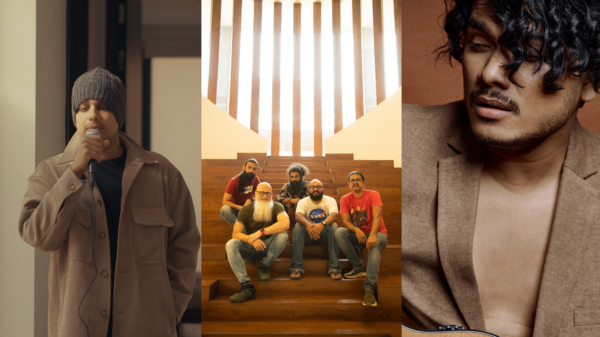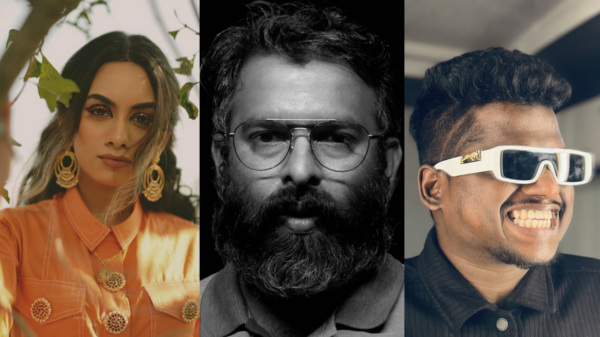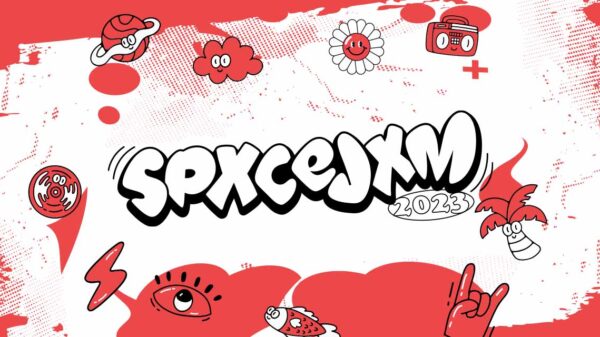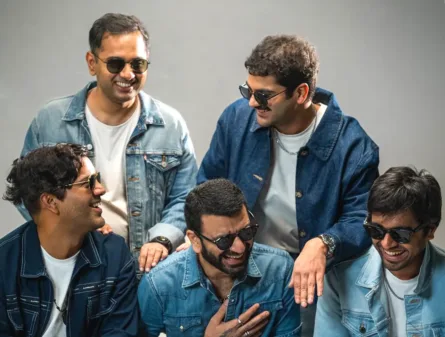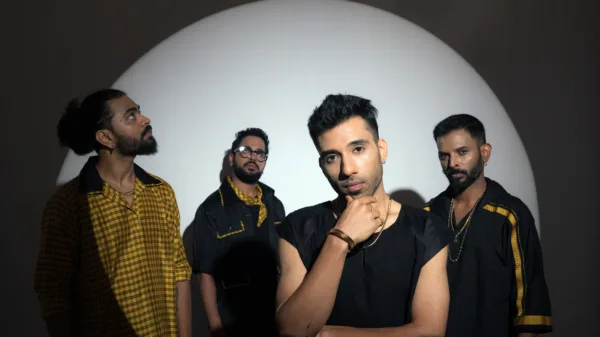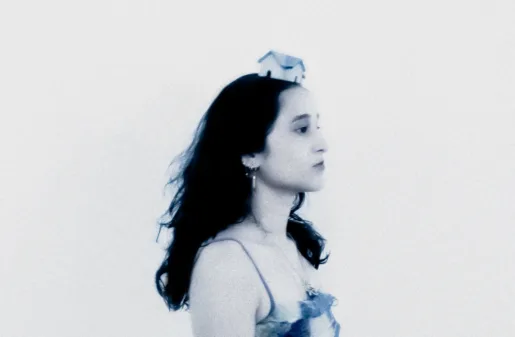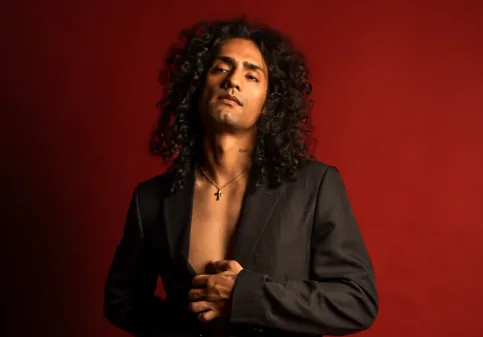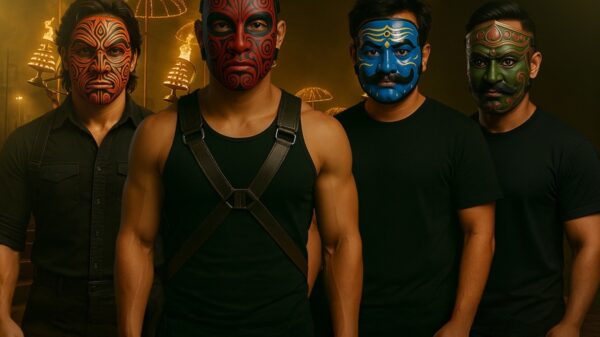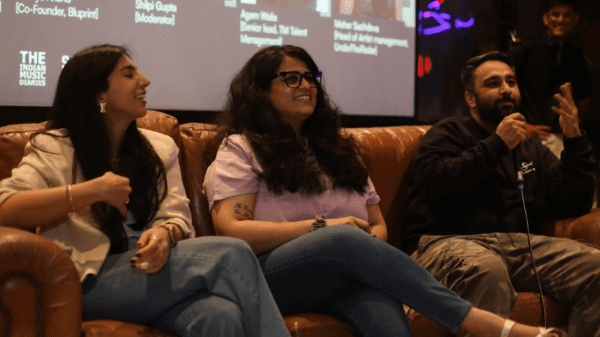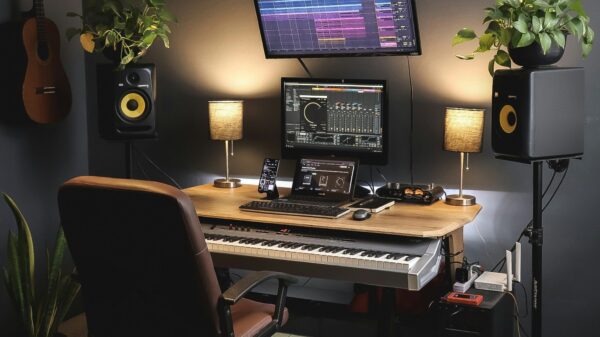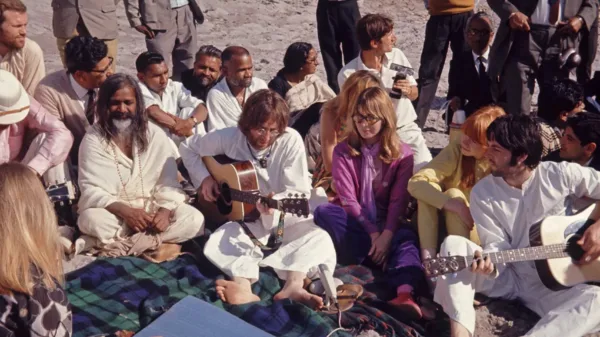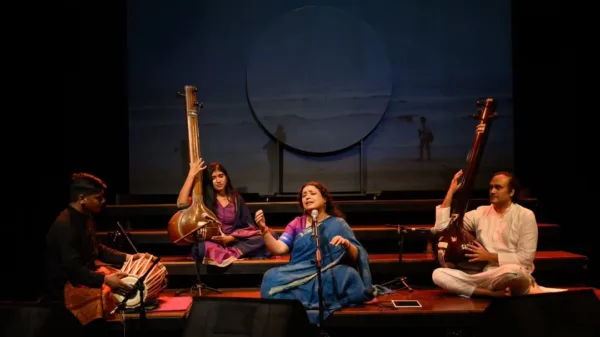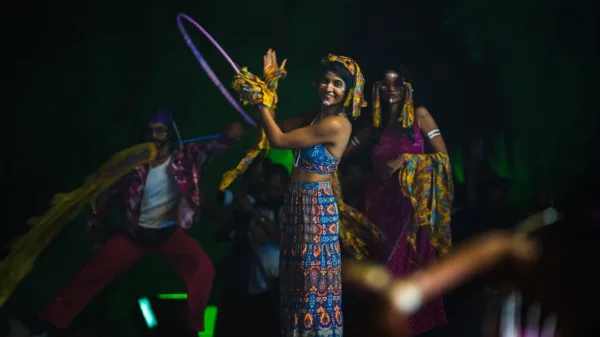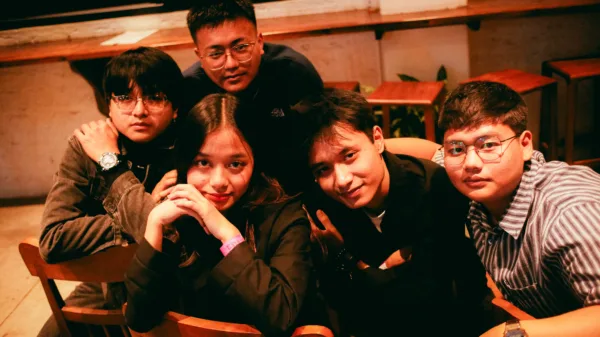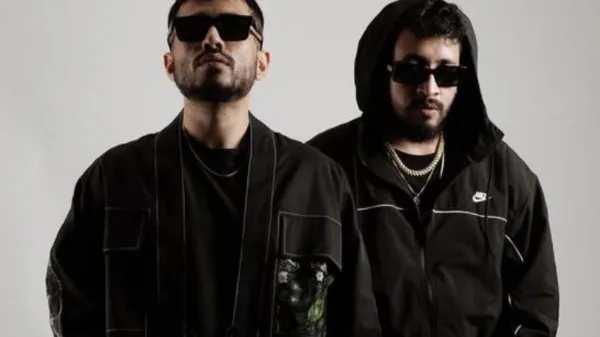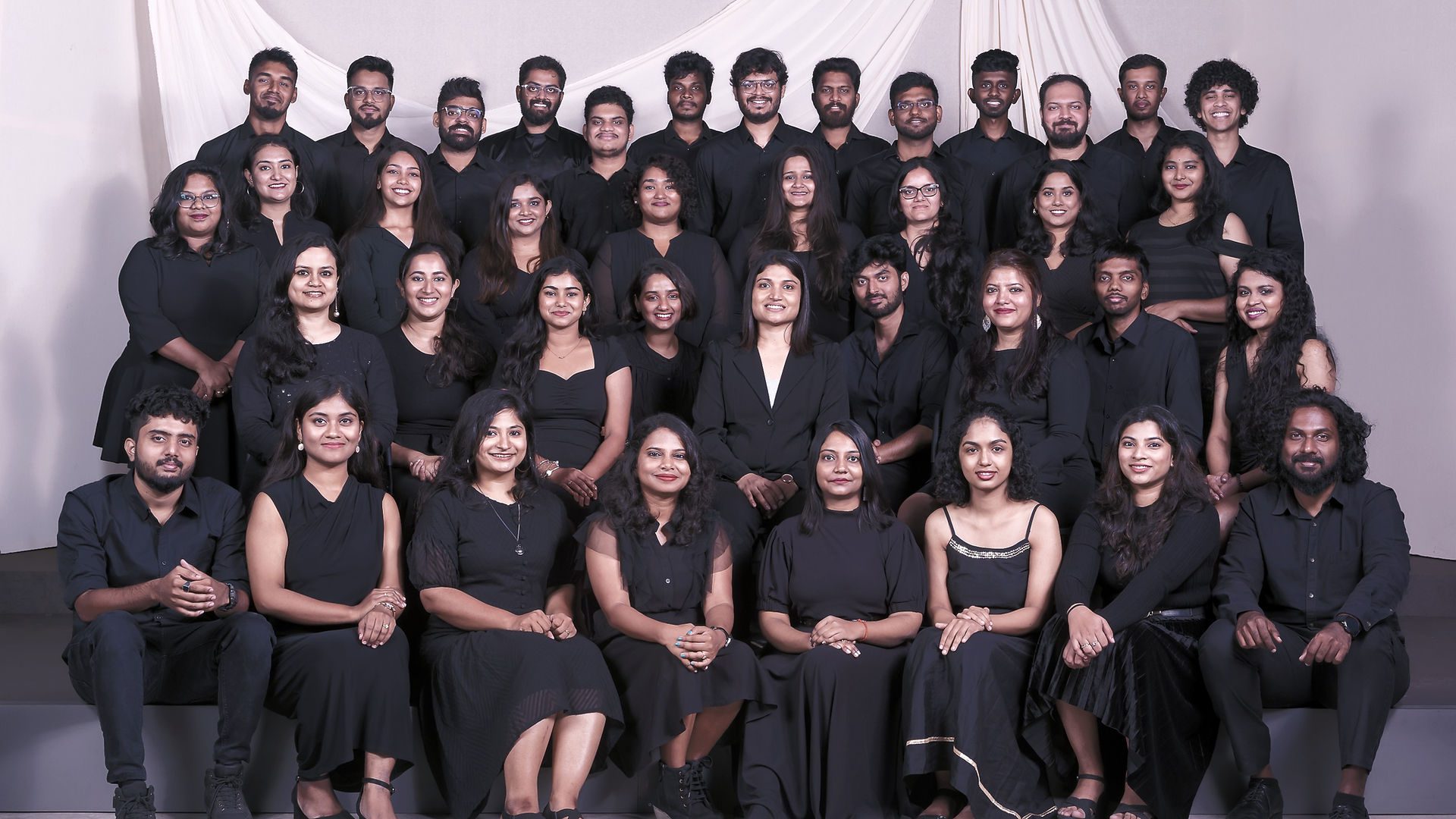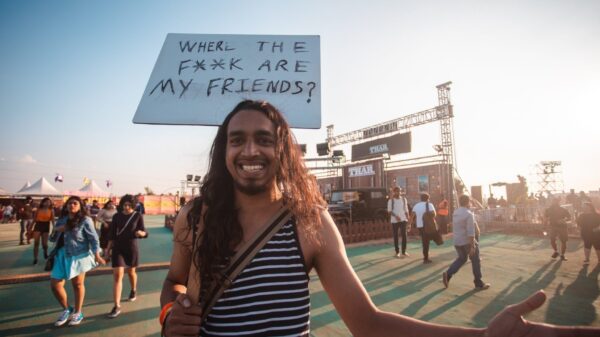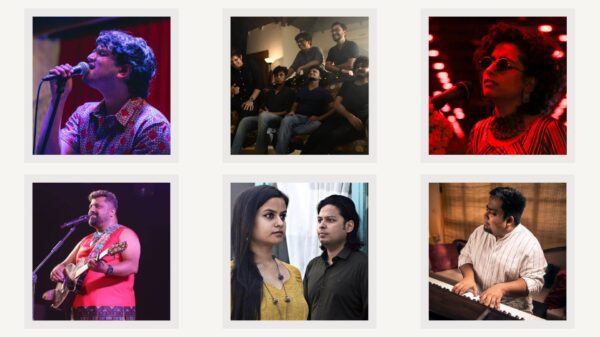The Indian Choral Ensemble isn’t a regular chorus group. The Chennai-based outfit led by Kalyani Nair and Karthik Manickavasakam is a diverse group of 40 singers, all trained and skilled in their respective diverse musicalities coming together to create ‘one’ cohesive sound that manifests into the personality of The Indian Choral Ensemble. The group’s collective output is a melting pot of harmony and tradition where art truly meets experience through music that anchors you to your roots while connecting you to the global music palette. I got introduced to their music through my super-seniors in Chennai, and was immediately blown away by the the sound of human voice turning and transforming, to catch the audience in a sublime and personal state of mind. I had the opportunity to have a conversation with Kalyani Nair and Karthik Manickavasakam, discussing different aspects of their music.
Kalyani Nair
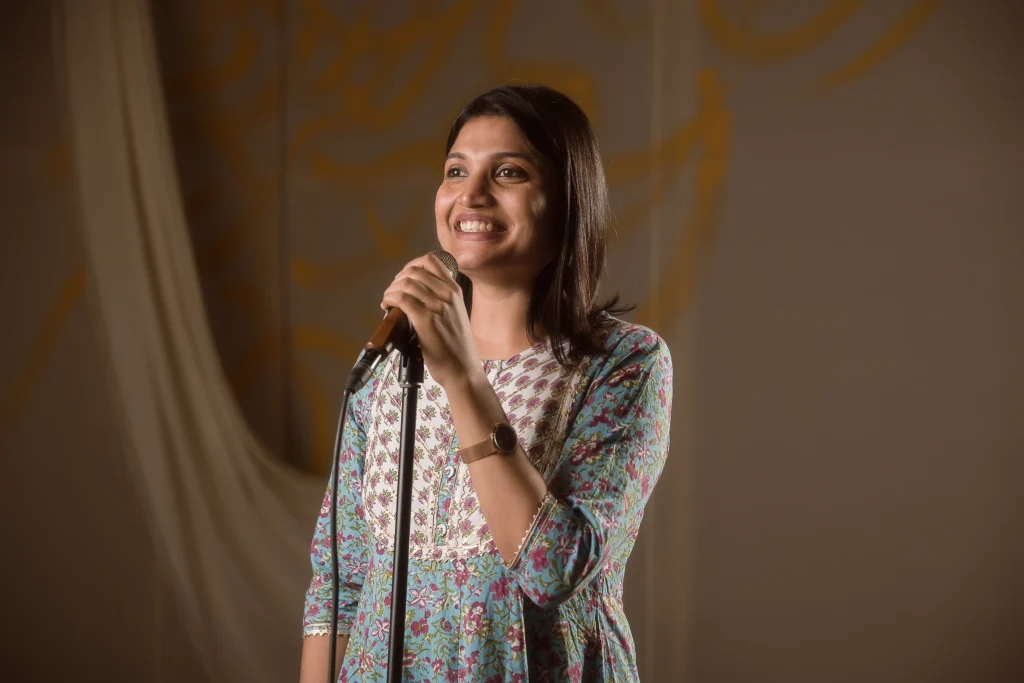
Kalyani Nair is a Chennai-based singer/songwriter/arranger with her work spread across industries and lanugages as an arranger and singer and also as an independent musician herself. Her recent album ‘Ula’ has been considered for Grammy across various categories. While talking about choral music and TICE in Indian context, she explains – “Choral music has always been accessible only to the niche and been associated with Church music, western classical repertoire or Group/Chorus singing in the Indian context. Recognising choral music as a style or genre through which we can tell tales of ordinary subjects, has hardly been explored in India and TICE has been trying to do this in the last 3 years. Our repertoire is based on simple, everyday life experiences, narrated through our melodies with a strong Indian flavor and embellished with intricate 6–8-part harmonies in voices. Our endeavor is to take choral music to the masses.”
Kalyani Nair’s story is an inspiring journey from being a singer and arranger, working in the industry to now co-founding TICE and being shortlisted for Grammy for her last album ‘Ula’ featuring The Indian Choral Ensemble. My curiosity wanted me to delve into her musical canvas which spans from pop to classical, to choral to contemporaries to the classics among other styles, so I asked her about her journey of musical growth. She shares – “My first introduction to music was through listening to old vintage Hindi film songs on cassettes and the impact that singers like Lata Mangeshkar, Geeta Dutt and composers like Salil Chowdhary, Madan Mohan and SD Burman had in my early years, still reflects in my style of singing and composition. In addition, owing to my defence background, I travelled widely and stayed in different parts of the country and the local music of the area impacted me strongly. I owe my openness in music, to this diversity that I was exposed to since childhood.
However, my formal training in music began only at the age of 18, under the tutelage of Mr Augustine Paul and that opened the world of western arrangement and composition for me. Composers like Mozart, Beethoven, Rachmaninoff and Ravel are composers I often go back to. Simultaneously, my friendship with some of the best musicians in today’s times like Pradeep Kumar, Sean Roldan and Santhosh Narayanan, influenced my musicianship a lot. Orchestral film scoring works for these composers helped me in learning the craft better and my listening expanded to international film composers like Ennio Morricone, John Williams and Thomas Newman.
My insatiable thirst for writing original music for voices led to the formation of The Indian Choral Ensemble and I think all my Indian and western influences from all these years reflect in my compositions of TICE.”
1. Congratulations on the Grammy Consideration for your last album. How does it feel to put Indian music on a global stage?
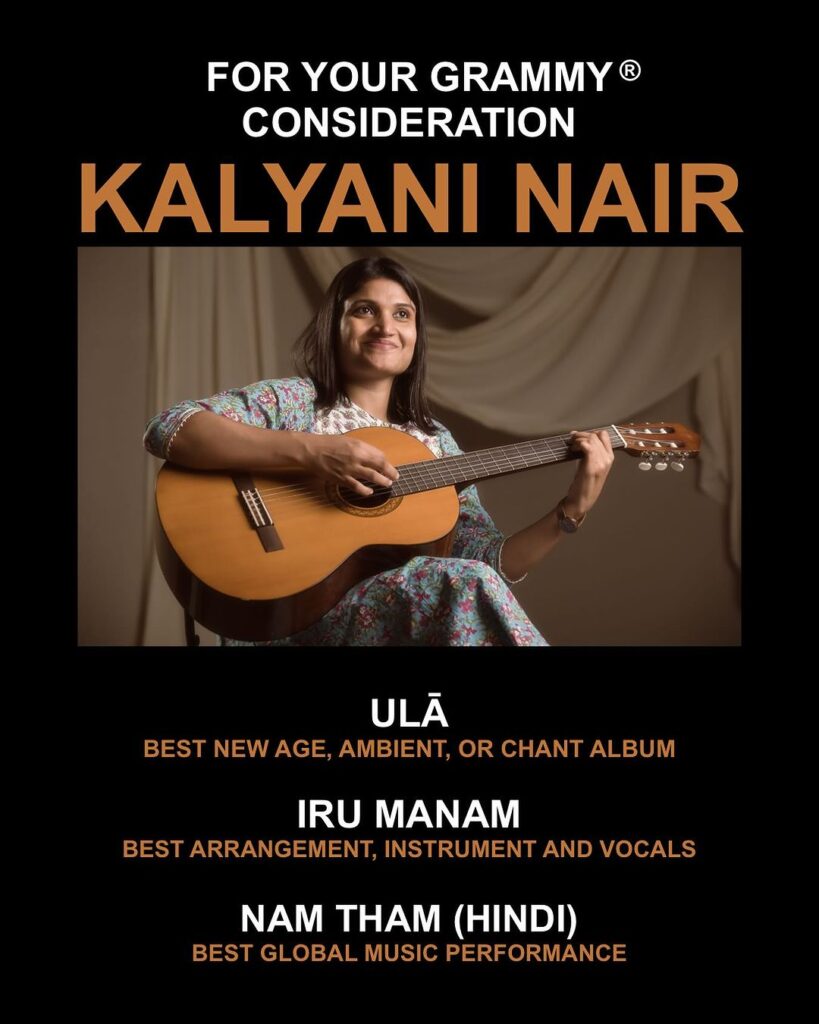
It is an honor to be associated with the Recording academy as a voting member this year and to have been able to submit my album Ula featuring TICE for the 67th Grammy consideration. Grammy is something that I have seen on TV and always seemed far-fetched but to have finally been able to send my own album to this, has been quite fulfilling irrespective of the result. This new association has enabled me to connect and share music with many international artists across the globe, helping me widen my musical perspective and I consider this itself as a big “win”.
2. You’ve transitioned from being a musician in the film industry to independent projects like Yodhakaa, The Harmonize Project, to building an independent repertoire while co-founding The Indian Choral Ensemble. Where do you see your musical journey going from here?
Compared to singing, I am a newbie to the field of composing and I feel more urge than ever before to write and put out more and more original music, be it for TICE or films or any other projects. Simultaneously I also want to work in collaboration with different musicians to come up with interesting and new musical ideas.
3. TICE’s performances often feature a blend of Indian classical music and western harmony. What challenges or arise while arranging a raga-based song for a choir format?
I don’t approach any composition from the standpoint of creating it in a particular ragam. For example, my composition Nam Tham has a proper Kalavati raag section in the opening, however the last chord of that section breaks the rule of Kalavati but it is intentional because it still aligns with the emotion that is created with Kalavati and from there the composition moves to several other modes.
Even while arranging songs that are melodically set to raagams like Bharathiyaar’s Chinnanjiru Kiliye, I don’t look at chords as notes in the raaga because then I am limiting my harmonic possibilities. I choose chords based on the emotion it creates in me and whether or not that emotion aligns with the raagam, becomes my criteria to choose certain chords over others.
4. Nam Tham has has a very sublime and healing effect. The music video also carries the elegance. When did the song come into picture? Can you take us through its journey from its inception to the final music video release?
The opening section of Nam tham was composed way back in 2009-10 as a 1-minute theme for a music festival. I tracked a 25-piece choir for that but somehow the event didn’t happen and the song just lay in my home archive until 2019, when during covid, I pulled out this old composition and felt the urge to develop it. Within 2-3 days I wrote the whole composition as you hear it today. Initially I wrote the song in Hindi dedicating it to my first born, Poorvi. It was at this stage that I reached out to Karthik Manickavasakam to help me find a vocal ensemble to perform my song Nam Tham, which started with a handful of his students at the KM music Conservatory initially and slowly grew to the 40 member TICE that you see today. So Nam tham has and will always be a special song for all TICE members as it was the reason that brought us together.
Slowly once I wrote more original songs for TICE, I wanted to release all the songs and to begin with, I tracked the then 22-piece TICE in 2021. Due to financial constraints, I had to wait longer until 2023 to finish producing the whole album.
Once the audio was done, the video happened quickly, thanks to having in-house talents in the choir like Neeraj M Selva, who took care of the entire ideation, direction and shooting of the whole song video and Samanvitha G Sasidaran who choreographed and danced in the video.
5. Can you tell us about the experience of working with the Budapest Scoring Orchestra on the album?
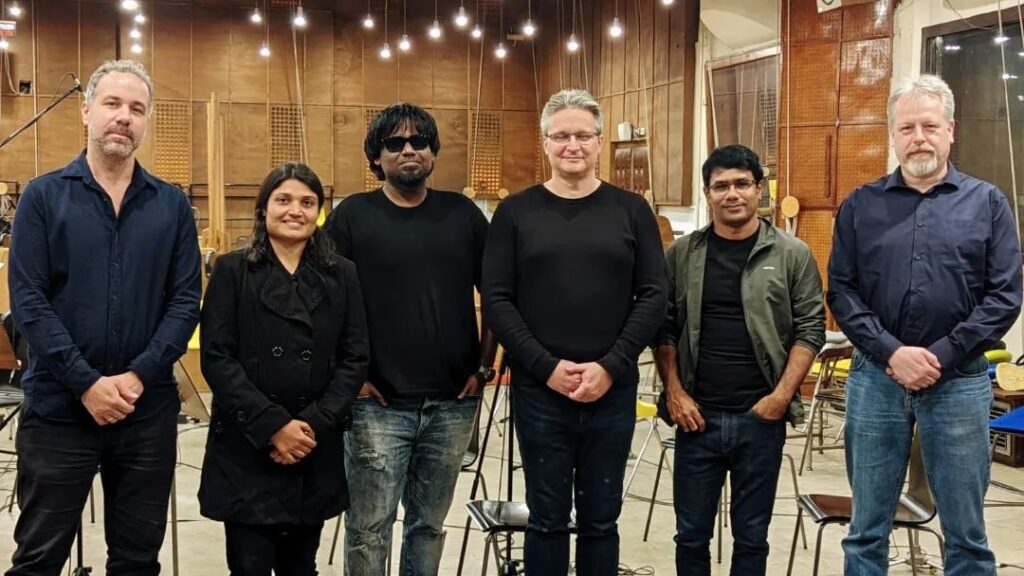
Pradeep and I had the fortune of being associated with the BSO from 2019 on several of his film projects starting with Sillukarupatti, Veyil, Andhagaaram, to name a few. Having worked on multiple projects with them both remotely and in person at their studio in Budapest, I have developed an ease of working with them on all kinds of scores that I write and my immediate choice of orchestra when it came to Ula, was BSO. The depth in the sound of their string section, the skillset and sensibility of the musicians and conductors in adapting to our Indian music has led to a long ongoing musical collaboration with them.
6. How was the Coke Studio Tamil experience for TICE?
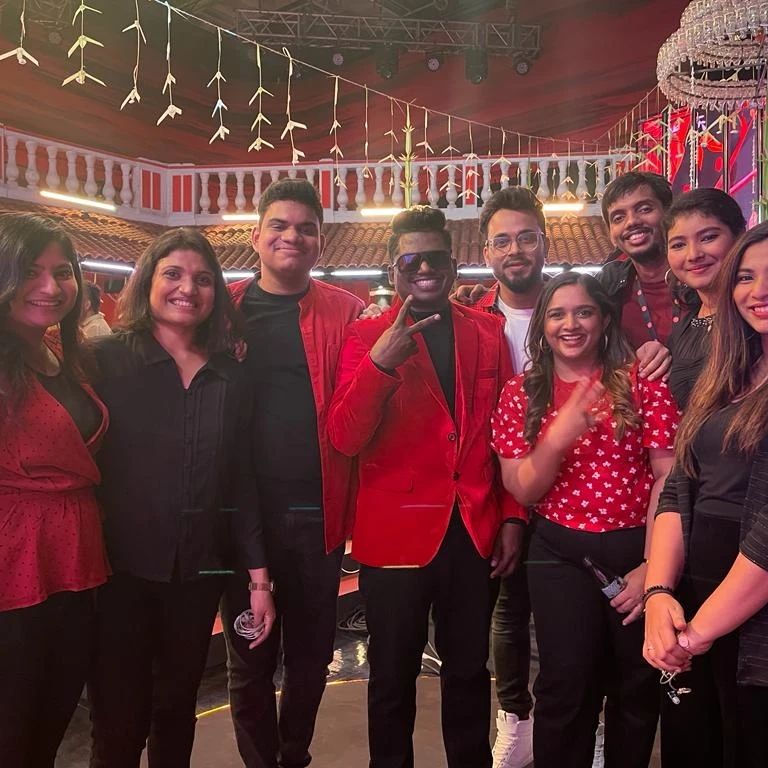
Working with Sean Roldan has always been special for me and I feel some of my best arrangement works have happened on his compositions and the fact that a huge brand like Coke Studio enabled this collaboration made it even better as it gave TICE a good visibility, though we could take only a chamber sized ensemble of about 8 voices in both seasons 1 and 2. We continue our association with Coke studio outside of this too as one of Sean’s songs from the first season of Coke Studio Tamil named Vendum has always been a constant on our repertoire list till date.
7. Which Indian independent artists do you admire? What do you think of the current state of Independent Music scene in India and what needs to change?
Indie artists – Pradeep Kumar and Sean Roldan, Indie projects – Poorvaa, Sean Roldan and Friends. I definitely see a change in the attitude of the general public over the last 20 years towards indie music. We have come a long way from when indie shows always ran on Zero-budgets to current times when there are Indie festivals being organized where people are willing to pay and come to listen to Indie bands. However, the financials associated with Indie bands are still so small compared to that of film music and unless that changes, it’s going to be a struggle for Indie musicians to put out their music. We need to have a better organized and transparent system to support Indie musicians to fearlessly make more music and bring it out to people.
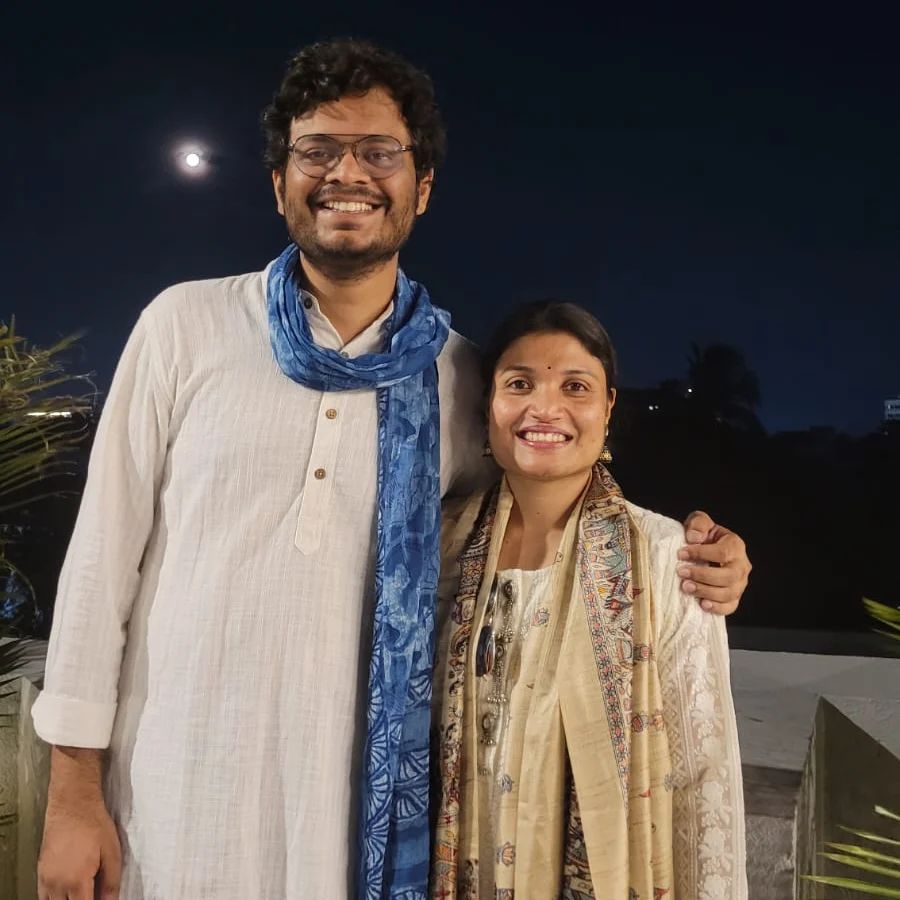
Karthik Manickavasakam
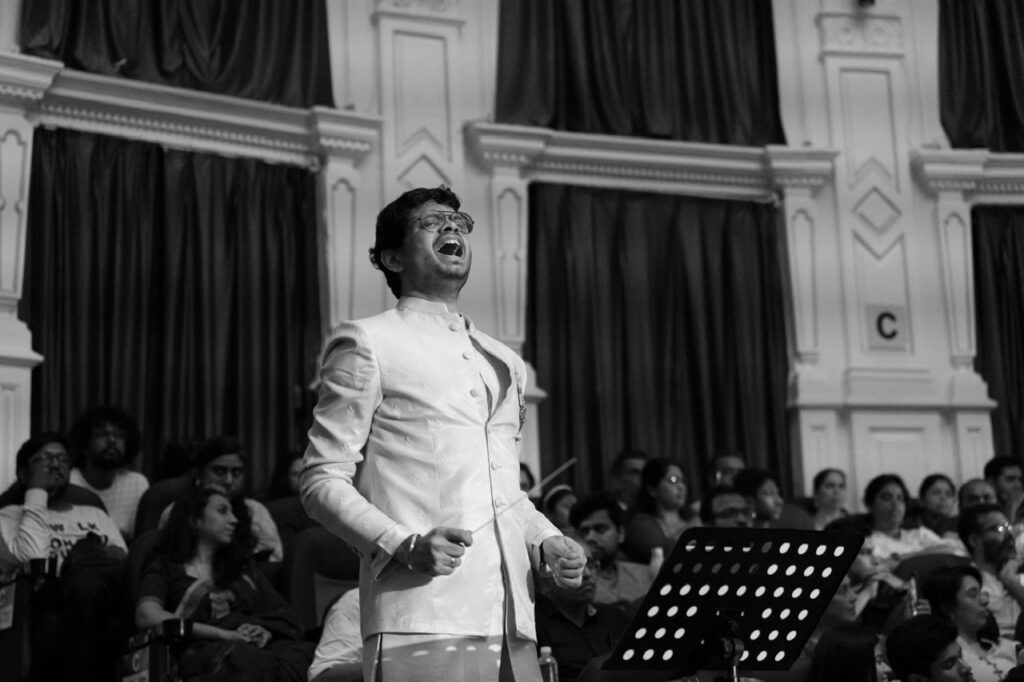
Coming to another pillar of The Indian Choral Ensemble, Karthik Manickavasakam, Chennai-based composer/arranger and independent musician who also co-leads The Indian Choral Ensemble along with Kalyani Nair. He initially founded a group called Harmony Bunch during lockdown, arranging and singing classics and popular music for acapella. The group has since developed into what we know as The Indian Choral Ensemble today. It’s so refreshing and only a Youtube search away. During my conversation with him, he shared some very inspiring and unique perspective on the nature of choral music and India’s gradual growing appreciation of the culture. “In India, people often associate the sound of a choir with either church music or Western classical traditions. With TICE, Kalyani and I are building a repertoire that tells stories everyone can relate to, incorporating elements of our native music. We are writing music in our regional languages.” – he shares.
Origin stories always excite me. My inquisitiveness led me to asking him about his learning years. He recalled – “I started composing and writing songs even before I had any formal training. My music was a tool to express myself when words failed. I used to rely on DAWs to imitate the melodies I had in my head, although my musical vocabulary was very limited. Now, having studied music and worked with some of my favorite musicians in this country, the core of what I do remains the same. I love Tchaikovsky, Debussy, and Schubert. I also love Coldplay, the Beatles, and Eric Whitacre. Today, Jacob Collier is someone who inspires me both musically and personally.”
1. We’ve seen your diverse work as an educator, singer, composer, arranger, and conductor, founding Harmony Bunch etc. What moments stand out in the journey that have led to the The Indian Choral Ensemble?
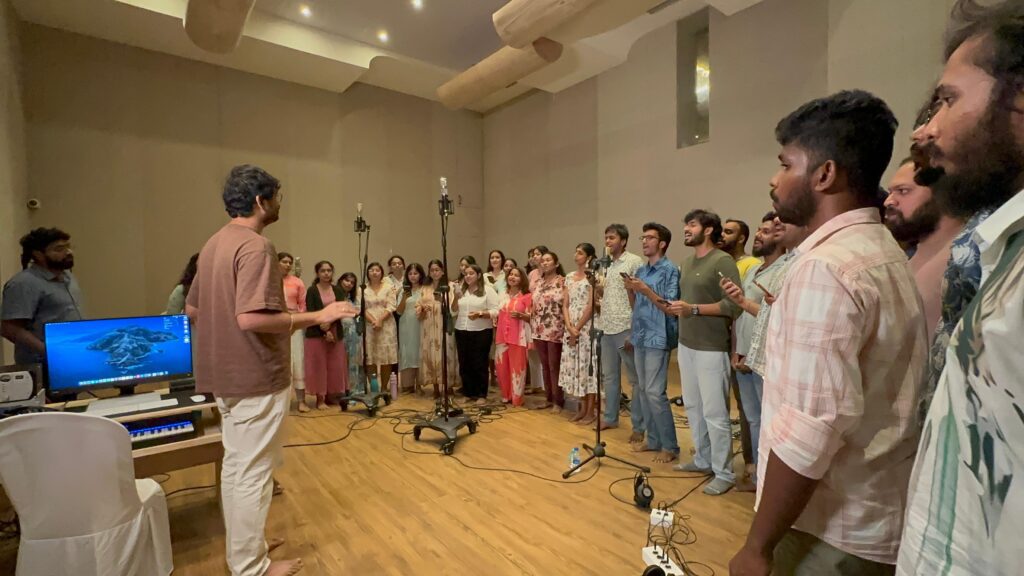
I always love to meet people on a level where they are uninhibited, where they express themselves freely, where their emotions are at their peak, where they are vulnerable yet strong. Everyone is so beautiful at that level. I try to approach everything in the same way, whether as a teacher, a musician, or a friend. That’s what led to the creation of my first band, Pithukuli, and my first ensemble, Harmony Bunch. With TICE, that’s exactly what I like to do. These guys are a very talented bunch, and I just add a bit of craziness to the mix.
2. Can you share some memorable recording and arranging experiences with the choir? What is it like to record such a diverse group of people?
TICE is doing fantastic work in film recordings. Recently, we were part of some notable film scores, such as Kalki and Manjummel Boys. I was fortunate to work with Santhosh Narayanan on the Kalki score, where I orchestrated for live strings, brass, woodwinds, and choir. TICE was instrumental in making some of the scores sound bigger. It’s always a composer’s pleasure to have 40 singers record together, as that offers rich textures and a vast space in the music. Ten singers dubbing four times is never the same as 40 singers recording together.
3. Your social media gives us glimpses into TICE’s group dynamics and fun elements. Can you take us behind the scenes of TICE’s culture?
We are often stuck in a box, feeling insecure, constantly fighting to make an impression or gain attention. There’s no one to blame—music is still considered a luxury in many families here, and making a career out of it is hard. But everyone has a beautiful story of how they became a musician, and I just keep reminding them of that. The culture we follow at TICE is to enjoy the process because that’s where the most fun lies.
4. What is your philosophy behind the art of conducting? How does it ensure an impactful performance from rehearsals leading up to the show day?
As a conductor, I see my role as guiding the choir in telling the story of the piece, unifying their sound while also creating an environment where they can express themselves freely. With each rehearsal, our relationship grows stronger, and we come to understand one another as a group, finding a balance between expressing ourselves and making space for others. I think that’s the beauty of performing orchestral music—there are many narratives happening in parallel, and everyone has a role to play.
5. What are your observations on the development of chamber, orchestral, and choral music in India? What direction do you see choral music taking in the future?
Our native music places a lot of focus on melodic development and less on textures. But people these days listen to all kinds of music, thanks to the internet and social media. Soon, everyone will develop a taste for orchestral aesthetics. I always believe that when your art is honest, it reaches people no matter where they are.
6. Which Indian independent artists do you admire? What do you think of the current state of Independent Music scene in India and what needs to change?
In India, Easy Wanderlings and B Prasanna are my favorites. In Chennai, I love Oorka, Kulam, and Sean Roldan & Friends. I also enjoy what Ofro does with Atti Culture.
In India, non-film music is considered to be independent music. I think independent music is where artists express themselves fearlessly and, most importantly, honestly. So, I wouldn’t want anything to change in that regard because, even if an artist is overlooked now, it becomes part of their journey, and they will eventually be discovered. The beauty of independent musicians is that their music impacts listeners on a personal level and eventually becomes part of their playlists. However, one thing I would like to see change is the availability of more indoor performance spaces, where artists can perform their music without any compromise on their sound.

